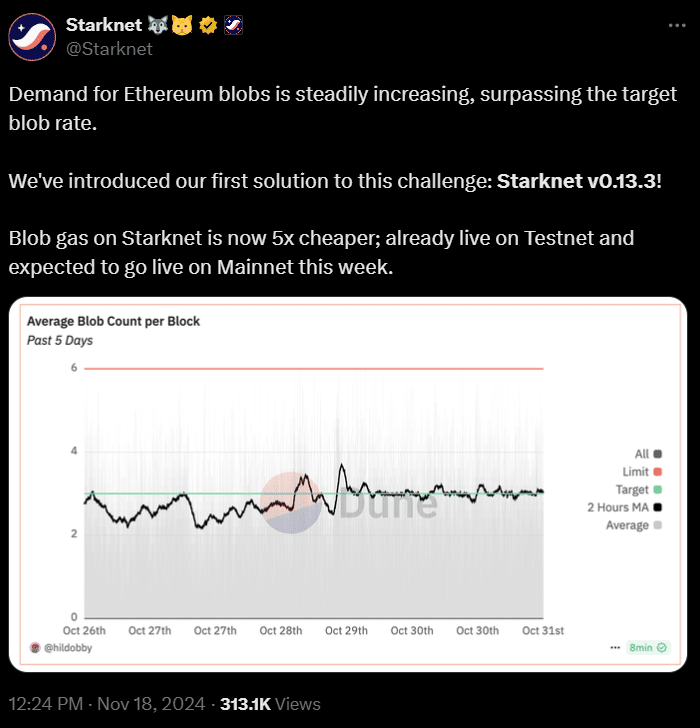Starknet has introduced version 0.13.3, addressing the growing demand for Ethereum blobs by reducing blob gas prices by 5x.
According to the press release, this update is already live on the Testnet and will be available on Ethereum’s Mainnet soon.

Blobs, short for ‘binary large objects’, are used to store data when transactions occur on Layer 2 rollups. Ethereum’s main network (Layer 1) handles the core operations, while Layer 2 networks, like Starknet, handle transactions more efficiently.
The blobs contain this transaction data, and when these blobs are posted to Ethereum’s Layer 1, they take up space on the blockchain. As the demand for transactions increases, so does the need for blobs. This naturally leads to higher costs for users if the price of storing and processing these blobs rises.
To address this, Starknet has introduced two key solutions: ‘state-diff compression’ and ‘transaction squashing’.
Transaction squashing combines multiple transactions into a smaller number of blocks, so users only pay for the actual data added by their transaction. In the past, every transaction paid the full price for the data in each block, even if that data was shared with other transactions.
Now, Starknet estimates the data contribution of each transaction and applies a discount to reflect the shared data within a block. This ensures that users only pay for their share of the data, reducing costs.
The second update, ‘state-diff compression’, reduces the size of the data before it is sent to Ethereum’s Layer 1. Together, these changes make blob gas 5 times cheaper and ensure that users only pay for their share of the data, reducing costs.
Last month, the average number of blobs per Ethereum block increased by 43%, reaching a target of around 3 blobs per block, as reported by Dune Analytics.
This rise in blob fees is positive for Ethereum’s tokenomics because it contributes to the burning of ETH. Similar to how Ethereum burns a portion of its base transaction fees, blob fees are also burned, which helps reduce the supply of ETH in circulation. For example, according to data from Ultra Sound Money, 21.17 ETH was burned in the past week alone due to blob fees.
Vitalik Buterin, Ethereum’s co-founder, recently highlighted Starknet’s efforts in improving Layer 2 scaling, saying, “One part of L2 scaling is Ethereum increasing its blob capacity. The other part is rollups becoming more data-efficient. Good to see Starknet rising to the challenge.”
Looking ahead, Starknet plans to continue improving blob usage. In future versions, such as Starknet v0.13.4, they plan to introduce ‘stateful compression’, which will further optimize how storage keys and contract addresses are handled.
Also Read: EIP-7809 to Bring Native-Like Capabilities to Ethereum Tokens



